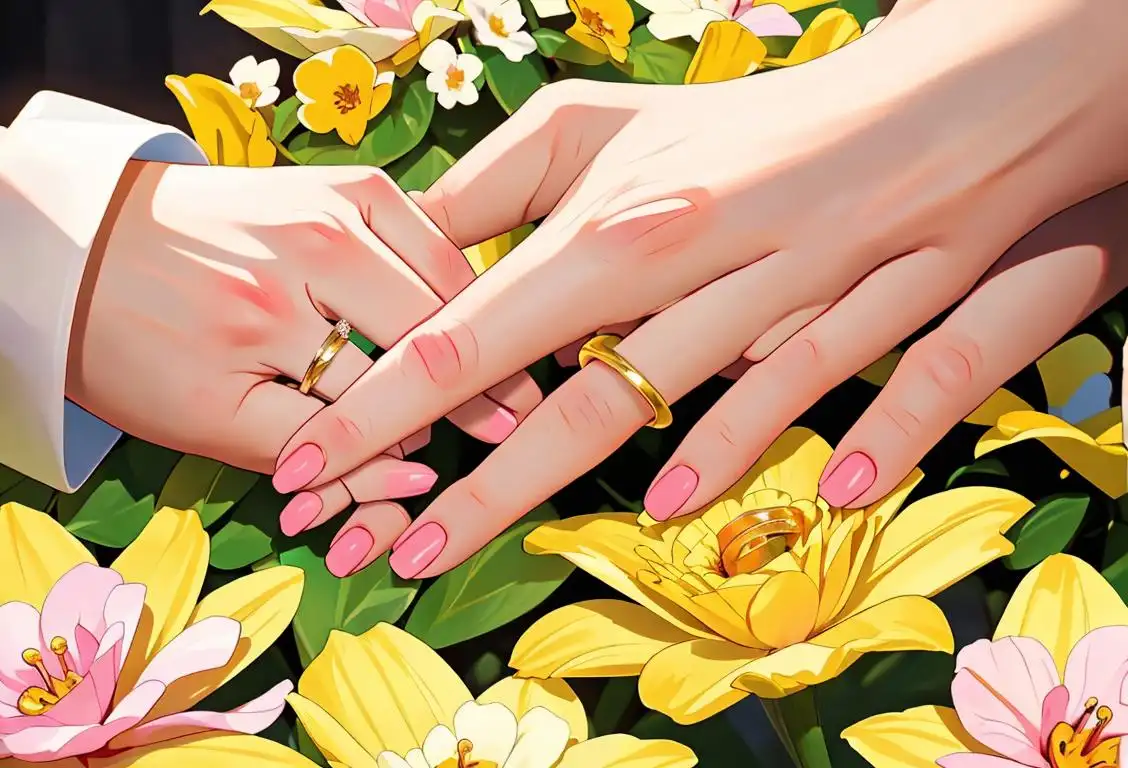National Wedding Ring Day

Ah, love is in the air! It's time to celebrate National Wedding Ring Day, a day dedicated to that special symbol of commitment and eternal devotion. Whether you're already married, engaged, or still dreaming of finding your soulmate, this day is a perfect opportunity to appreciate the beauty and significance of the wedding ring.
When is Wedding Ring Day?
It's national wedding ring day on the 3rd February.
The Origins of National Wedding Ring Day
Why do we set aside a whole day to celebrate wedding rings, you ask? Well, let me take you on a journey through the internet history of this delightful day.
Although the exact origin of National Wedding Ring Day is shrouded in mystery, its significance can be traced back to the time when exchanging rings became a popular tradition in wedding ceremonies. Wedding rings have been used symbolically to represent the eternal love and commitment between spouses for centuries.
As the internet grew in popularity, people began sharing their wedding ring stories and showcasing their beautiful bands online. Social media platforms, such as Facebook, Twitter, and Instagram, became inundated with gleaming diamond rings and precious metal bands, inspiring the creation of National Wedding Ring Day.
On this special day, couples young and old take to the internet to share photos of their rings, tell their engagement stories, and gush about how lucky they are to have found their life partner. It's a day filled with joy, romance, and a whole lot of sparkle!
How to Celebrate
Now that you know the history, let's dive into how you can celebrate National Wedding Ring Day!
1. Show off your bling: Take a stunning photo of your wedding ring and share it on social media using the hashtag #WeddingRingDay. Let the world bask in the beauty of your eternal symbol of love!
2. Renew your vows: Use this day as an opportunity to renew your wedding vows with your spouse. Recommit to each other and cherish the bond you share.
3. Treat your ring to a spa day: Just like we need a little TLC every now and then, so does your wedding ring! Give it a gentle cleaning to make it sparkle like new.
4. Surprise your partner: Plan a surprise date night or a romantic gesture to show your partner how much they mean to you. It's the perfect day to express your love and gratitude.
Did You Know?
Did you know that in ancient Egypt, wedding rings were believed to be a symbol of eternity? The Egyptians believed that the circular shape of the ring signified a love that had no beginning or end. So, when you slip that ring on your finger, remember that you're part of a tradition that dates back thousands of years!
History behind the term 'Wedding Ring'
860
Romantic Roots
The concept of wedding rings can be traced back to around the year 860. It was during this time that Pope Nicholas I made a declaration that couples should exchange a token of their commitment during the wedding ceremony. This token was often a simple iron ring.
2800 BC
Ancient Egypt: The Circle of Infinity
As early as 2800 BC, ancient Egyptians were known to exchange rings made from braided reeds and sedges. These rings were circular in shape, symbolizing eternity and the eternal love between the couple. The Egyptians believed that the ring's circular shape represented a never-ending bond of love and commitment.
3000 BCE
Ancient Origins
In ancient Egypt, the earliest recorded evidence of wedding rings dates back to around 3000 BCE. These early wedding rings were made of natural materials such as reeds, bone, or leather. The circle shape of the ring symbolized eternity, with no beginning or end, representing the couple's eternal love and commitment to each other.
3000 BCE
The Ancient Egyptians and the Circle of Eternity
In ancient Egypt, the concept of eternal love and commitment was symbolized by the circle, which had no beginning or end. Egyptians believed that the fourth finger of the left hand had a special vein, called the 'vena amoris' or 'vein of love,' that connected directly to the heart. They began the tradition of wearing a band made of woven reeds or plants on this finger as a symbol of love and fidelity.
1477
The first recorded use of a wedding ring
In 1477, the first recorded use of a wedding ring was found in a text called 'Le Ménagier de Paris', written by a French author. In this text, the author advised husbands to give their wives a ring during the wedding ceremony as a symbol of love and commitment.
3000 BC
Ancient Beginnings
In ancient Egypt, the tradition of exchanging rings dates back to around 3000 BC. The Egyptians believed that the circle represented eternity, and the space in the center of the ring was a gateway to the unknown. These early rings were typically made from plants and reeds, which symbolized the circle of life and the unending cycle of love.
2800 BC
Ancient Beginnings
Wedding rings trace their origins back to ancient Egypt, around 2800 BC. The ancient Egyptians believed that the circle was a symbol of eternity, with no beginning or end, and they incorporated this concept into their wedding ceremonies. Rings made from braided reeds or bone were exchanged by couples as a symbol of their eternal love and commitment.
3000 BC
Ancient Origins
The history of wedding rings dates back to ancient times. The Egyptians, around 3000 BC, were among the first civilizations to exchange rings as a symbol of everlasting love. These rings were typically made of braided reeds or other natural materials.
1215
The Beginnings of the Exchange
The tradition of exchanging rings as part of a wedding ceremony can be traced back to ancient Egypt, but it was in the year 1215 that the term 'wedding ring' first appeared in historical records. This was during the reign of Pope Innocent III, who declared that during a wedding ceremony, a ring should be given by the groom to the bride as a symbol of their commitment and love.
3000 BCE
Ancient Beginnings
Wedding rings have a long history that dates back to ancient times. The tradition of exchanging rings during weddings can be traced all the way back to ancient Egypt and Mesopotamia around 3000 BCE. At this time, couples would exchange braided rings made from reeds and grasses. These early rings symbolized the eternal and unending love between the couple.
3000 BCE
Ancient Egyptians Begin the Tradition
The concept of wedding rings dates back to ancient Egypt around 3000 BCE. Egyptians viewed the shape of a circle as a symbol of eternity, representing an eternal bond between the couple. Moreover, they believed that the ring finger contained a special vein, called the "vein of love," which was directly connected to the heart. This belief led to the tradition of wearing the wedding ring on the fourth finger of the left hand.
1477
The First Diamond Engagement Ring
In 1477, Archduke Maximilian of Austria proposed to Mary of Burgundy with the very first recorded diamond engagement ring. This marked a significant shift in the history of wedding rings, as diamonds began to be associated with engagement and symbolized everlasting love.
1500 BCE
Ancient Greeks Adopt the Tradition
The ancient Greeks also embraced the practice of exchanging wedding rings. They associated the circle shape with the concept of unity and love. Additionally, they believed that the fourth finger of the left hand had a vein, referred to as the "vena amoris" or "vein of love," that connected directly to the heart. The Greeks considered wedding rings as a sign of commitment and allegiance.
850 AD
The First Diamond Engagement Ring
During the medieval era, the concept of the diamond engagement ring began to take shape. The first recorded instance of a diamond engagement ring dates back to 850 AD, when King Maximilian I of Germany proposed to Mary of Burgundy with a gold ring adorned with small diamonds in the shape of her initial 'M'. This marked the beginning of the association between diamonds and betrothal.
2nd Century BCE
Roman Pledge of Love
During the Roman Empire, the tradition of the wedding ring evolved further. In the 2nd century BCE, Romans began to exchange rings made of iron to symbolize a legal and binding agreement of marriage. The iron rings were worn by wives as a sign of their husband's ownership. These rings were not worn in public but were reserved for the home.
200 BCE
The Romans and the Iron Bands
During the Roman Empire, the tradition of exchanging wedding rings evolved. Instead of reed or plant bands, couples started using iron rings to symbolize strength and permanence. Iron was chosen because it represented durability and security in their culture. These rings were worn by both men and women, marking one's status as a married individual.
330 AD
Roman Influence: The Beginning of the Metal Band
In the Roman Empire, the tradition of exchanging wedding rings continued but with a shift towards more durable materials. Around 330 AD, the use of metal bands, usually made of iron, became popular. These rings were not only a symbol of love but also a sign of ownership, as women were often considered the property of their husbands. The iron rings were later replaced by gold ones to signify wealth and social status.
1477
Diamonds Steal the Spotlight
In 1477, Archduke Maximilian of Austria gave a diamond ring to Mary of Burgundy upon their engagement. This marked a significant shift in the choice of gemstones for engagement rings. The allure and beauty of diamonds quickly captured the imaginations of the wealthy and noble, making them increasingly popular as a symbol of love and a crucial component of wedding rings.
2nd Century BCE
Roman Tradition
The Romans adopted the tradition of wedding rings from the Egyptians. The rings were generally made of iron and worn only by women at this time. It was during the 2nd century BCE that the Romans began using gold rings, symbolizing wealth and status. These rings often had intricate designs and were considered a sign of love and fidelity.
850 AD
The Vena Amoris
The tradition of wearing wedding rings on the fourth finger of the left hand can be traced back to ancient Rome. The Romans believed that a vein connected the fourth finger, also known as the ring finger, directly to the heart. They called this vein 'vena amoris,' meaning the vein of love. This belief led to the practice of wearing the wedding ring on the left hand's ring finger, symbolizing the connection of love between two individuals.
2nd century BC
The ancient Romans and Egyptians use wedding rings
Although the specific term 'wedding ring' was not yet in use, the ancient Romans and Egyptians were known to exchange rings during wedding ceremonies. The Romans believed that the ring symbolized ownership, while the Egyptians saw it as a symbol of eternity and the never-ending cycle of life.
860 AD
Introducing Gold Rings
Gold wedding rings first appeared during the medieval period. In 860 AD, Pope Nicholas I declared that a gold ring should be used as a symbol of marital commitment in Christian ceremonies. This declaration laid the foundation for the tradition of wearing gold wedding rings, which continues to this day.
860 CE
Christians and the Symbolism of the Ring
In the Christian church, the wedding ring began to take on additional significance. It became an official symbol of the sacrament of marriage and was blessed by the officiating priest during the wedding ceremony. This religious blessing bestowed divine grace upon the ring, making it a sacred symbol of unity and commitment.
1477
First Diamond Engagement Ring
The concept of using diamond rings as engagement rings can be attributed to the year 1477 when Archduke Maximilian of Austria proposed to Mary of Burgundy with a diamond ring. This event marked the beginning of a trend, as diamonds became increasingly popular for engagement rings among the wealthy and nobility. The tradition of diamond engagement rings symbolizing love, commitment, and prosperity steadily spread throughout Europe.
860 CE
Christian Influence
With the spread of Christianity, wedding rings took on a deeper meaning. In 860 CE, Pope Nicholas I declared that a ring should be used in marriage ceremonies as a symbol of the unity and fidelity of the couple. This declaration solidified the significance of wedding rings in Christian marriage rituals, and the tradition started to gain widespread acceptance.
1477
Diamonds and the Classic Solitaire
In 1477, Archduke Maximilian of Austria presented Mary of Burgundy with a diamond engagement ring, which is considered the origin of the classic solitaire ring. This single diamond ring symbolized the unity of two souls, while the sparkle of the diamond symbolized the eternal flame of love. This pivotal moment in history solidified diamonds as the ultimate symbol of love and devotion.
9th Century
The Christian Influence
In the 9th century, the Christian Church played a significant role in shaping the tradition of wedding rings. The church declared that rings were to be a part of the official wedding ceremony, signifying the commitment and love between a couple. The rounded shape of the ring was believed to symbolize eternity and the never-ending love of God. As a result, wedding rings began to take on a more circular design.
9th Century
Christian Influence Emerges
During the 9th century, the Christian church began incorporating the exchange of rings into wedding ceremonies. The church regarded the wedding ring as a symbol of the union between a man and a woman under God. The circular shape symbolized eternity, while the opening in the center represented a gateway to future joys and blessings. This religious influence further solidified the significance of wedding rings in Western cultures.
1700s
The Emergence of Wedding Bands
During the 1700s, the use of wedding rings became more common among couples. The plain gold band started to gain popularity as a symbol of commitment during marriage ceremonies. The circular shape of the band was believed to represent eternity and the unbreakable bond between husband and wife.
1886
Tiffany & Co. Introduces the Tiffany Setting
In 1886, the prestigious jewelry company Tiffany & Co. introduced the iconic 'Tiffany Setting' for diamond engagement rings. This innovative design featured a raised six-prong setting that maximized the brilliance of the diamond. The Tiffany Setting revolutionized the engagement ring industry and solidified diamonds as the go-to choice for center stones.
1477
The Birth of the Diamond Engagement Ring
The tradition of diamond engagement rings can be traced back to 1477 when Archduke Maximilian of Austria proposed to Mary of Burgundy with a ring featuring flat diamonds in the shape of an 'M.' This event marked the beginning of the trend of using diamonds in engagement rings, eventually leading to the diamond-studded wedding rings we see today.
860 AD
The significance of the ring finger
In the 9th century, the Christian church declared the ring finger to have a special significance in wedding ceremonies. They believed that the ring finger had a direct connection to the heart, and that by placing the wedding ring on this finger, the couple's hearts would be forever connected.
1215
Medieval Europe: The First Recorded Use of Diamond
During the Middle Ages, diamond-studded wedding rings were introduced, marking a significant shift in symbolism. The first recorded use of a diamond in a wedding ring dates back to 1215 when the bishops' council in Paris declared that a diamond ring should be used in nuptial ceremonies. Diamonds, with their exceptional durability, purity, and sparkle, became a symbol of everlasting love and invincibility.
1477
Introduction of Diamond Engagement Rings
The tradition of diamond engagement rings became popular in 1477 when Archduke Maximilian of Austria proposed to Mary of Burgundy with a diamond ring. This sparked a trend among European nobility, and diamond engagement rings quickly became a symbol of wealth and status. The use of diamonds in engagement rings symbolized the enduring nature of love and the strength of the bond between the couple.
1867
The Tiffany Setting Revolution
In 1867, Charles Tiffany, the founder of Tiffany & Co., introduced the iconic six-prong diamond engagement ring setting known as the Tiffany setting. This innovative design allowed the diamond to be showcased in a way that maximized its brilliance and shine. The Tiffany setting revolutionized the way engagement rings were designed and set a new standard for elegance and luxury.
1864
The Technique of Electroplating
In 1864, the technique of electroplating was developed, and it revolutionized the creation of wedding rings. Electroplating allowed for a thin layer of precious metal, such as gold or platinum, to be bonded to a more affordable base metal, making wedding rings accessible to a wider range of people. This advancement led to the mass production of affordable wedding rings, ensuring that more couples could afford these meaningful symbols of love.
1922
The De Beers Marketing Campaign
The De Beers diamond mining company launched a groundbreaking marketing campaign in 1922 with the slogan 'A Diamond Is Forever.' This campaign aimed to associate diamonds with everlasting love and commitment, further strengthening the cultural significance of diamond wedding rings. It successfully established diamonds as a symbol of eternal love and solidified their place in the wedding industry.
19th Century
The Rise of the Modern Wedding Ring
During the 19th century, the concept of the wedding ring as we know it today emerged. Up until this time, engagement rings were predominantly adorned with diamonds, while wedding rings were simpler bands. However, as the Industrial Revolution took hold, the mass production of gold and silver allowed wedding rings to become more elaborate and personalized. Couples started to exchange matching wedding bands as a symbol of their eternal commitment to one another.
19th Century
The Rise of the Modern Wedding Ring
During the 19th century, jewelry became more accessible to the general public due to advancements in manufacturing techniques. This led to the popularity of gold and diamond wedding rings among a wider range of people. The use of precious metals and gemstones in wedding rings became a symbol of wealth and status.
1477
Diamonds Sparkle
The use of diamonds in engagement rings began in 1477 when Archduke Maximilian of Austria proposed to Mary of Burgundy with a ring adorned with diamonds in the shape of an 'M.' This event sparked a trend of using diamonds in engagement rings among the European nobility. The precious stone became associated with love, commitment, and wealth, leading to the popular phrase 'diamonds are forever.'
1477
Diamond's Reign Continues: Archduke Maximilian
In 1477, Archduke Maximilian of Austria gave Mary of Burgundy a diamond engagement ring, further popularizing the use of diamond rings in marriage proposals. This event marked the beginning of a trend among European nobility, who started presenting diamond rings as a symbol of betrothal, showcasing their power, wealth, and commitment to their beloved.
1475
Diamonds enter the scene
In the late 15th century, Archduke Maximilian of Austria gave Mary of Burgundy a diamond engagement ring, marking the beginning of diamonds becoming a popular choice for engagement and wedding rings among the aristocracy. This sparked a trend that would later spread to other social classes.
13th Century
First Recorded Use of Diamond Rings
In the 13th century, diamond rings entered the scene as symbols of engagement and marriage. The use of diamonds gained popularity due to their strength, durability, and rare beauty. The first recorded diamond engagement ring was given in 1477 by Archduke Maximilian of Austria to Mary of Burgundy. Soon, the association between diamonds and everlasting love became deeply ingrained within Western culture, forever changing the perception of wedding rings.
1477
Diamonds Sparkle as Symbols of Love
The use of diamonds in wedding rings gained popularity during the Renaissance period. It is believed that Archduke Maximilian of Austria introduced the tradition of diamond engagement rings when he gave one to his betrothed, Mary of Burgundy. The captivating beauty and rarity of diamonds quickly became associated with eternal love and luxury.
1947
The De Beers' marketing campaign
In 1947, the diamond company De Beers launched a marketing campaign with the slogan 'A Diamond Is Forever.' This campaign aimed to associate diamonds with eternal love and commitment. As a result, diamond wedding rings became even more popular and are now seen as a symbol of everlasting love.
1947
Platinum for Eternity: De Beers' Marketing Campaign
In 1947, the diamond company De Beers launched a groundbreaking marketing campaign that forever changed the diamond industry and the concept of wedding rings. Their famous slogan, 'A Diamond is Forever,' focused on promoting the idea that diamonds were not only a symbol of eternal love but also an everlasting investment. Additionally, platinum bands gained popularity due to their strength and versatility.
1947
Platinum's Modern Love Story
Platinum became a popular choice for wedding rings in the 20th century. Its durability, hypoallergenic properties, and lustrous appearance made it a symbol of enduring love and commitment. Platinum's popularity soared when it became the metal of choice for Prince Philip's engagement ring to Queen Elizabeth II in 1947, setting a fashionable trend for platinum wedding bands.
20th Century
Rise of Modern Wedding Rings
In the 20th century, wedding rings underwent further evolution in design and materials. Platinum and gold became the popular choices for wedding bands due to their durability and preciousness. Additionally, rings with intricate designs, engravings, and gemstone accents gained popularity, allowing couples to personalize their rings. The concept of matching wedding bands also emerged, symbolizing the unity and equality of the partnership.
2000s
Evolution of Ring Designs
In recent years, there has been a surge in the popularity of alternative engagement ring styles and designs. Couples are increasingly seeking unique and personalized rings that reflect their individuality. From vintage-inspired designs to non-traditional gemstones, the diversity of wedding ring options has expanded greatly, offering couples a broader range of choices to symbolize their love and commitment.
20th Century
Modern Innovations
In the 20th century, wedding ring styles and materials diversified. The introduction of new materials like platinum and white gold offered a contemporary twist to traditional gold bands. Additionally, variations in design and settings allowed for more personalization. Today, couples have a wide range of choices, from classic plain bands to elaborate diamond-encrusted rings, reflecting their individual tastes and styles.
20th Century
Customization and Symbolism
In the 20th century, wedding rings became further personalized and symbolic. Couples started engraving their initials, love messages, or significant dates on the inside or outside of the rings. Additionally, various designs and styles emerged, catering to individual preferences and cultural traditions.
1947
The De Beers Campaign
The diamond industry experienced a significant boost in 1947 when the diamond company De Beers launched their famous slogan 'A Diamond is Forever.' The campaign aimed to associate diamonds with eternal love and commitment, further popularizing diamond engagement rings. This marketing strategy solidified the diamond's status as the ultimate symbol of engagement and forever changed the wedding ring industry.
20th Century
Mass Production and Modern Variations
With advances in technology during the 20th century, the mass production of wedding rings became possible. This accessibility allowed couples from various socioeconomic backgrounds to afford and wear wedding rings. Alongside the traditional plain bands, an assortment of variations emerged, including different metals, gemstones, and intricate designs. This era marked the democratization of wedding rings, transforming them from symbols of elite status to common cultural norms.
1947
De Beers' Iconic Slogan
In 1947, the diamond company De Beers introduced the iconic slogan 'A Diamond Is Forever.' This marketing campaign aimed to foster the idea that a diamond symbolizes eternal love and commitment. The slogan was incredibly successful and further solidified the association between diamonds and everlasting love.
20th Century
Incorporating Other Precious Stones
In the 20th century, the tradition of incorporating other precious stones into wedding rings gained popularity. Birthstones and colored gemstones began to be featured alongside diamonds, allowing couples to incorporate personal meaning and symbolism into their rings. This trend continues today, with couples opting for unique combinations of stones that hold significance to their relationship.
Present Day
Symbol of Love and Commitment
Today, the wedding ring holds a profound significance in cultures worldwide. It serves as a symbol of love, commitment, and the eternal bond between two individuals. Whether adorned with diamonds, other gemstones, or a simple band, the wedding ring represents the unbreakable unity and devotion shared by married couples throughout their journey of life together.
Modern Era
Personalization and Symbolism
In the modern era, wedding rings have become highly personalized and symbolic. Couples often choose unique designs, incorporate birthstones, engrave meaningful messages, or opt for alternative materials to express their individuality. The significance of wedding rings has transcended their original purpose and now serves as a tangible symbol of love, commitment, and unity.
Present Day
Continued Significance
Wedding rings remain an essential part of marriage ceremonies across cultures and religions. They symbolize love, commitment, and unity between partners. While materials, designs, and trends may change over time, the tradition of exchanging wedding rings persists as a timeless symbol of matrimonial bonds.
Present Day
Enduring Symbol of Love
Today, the wedding ring remains an enduring symbol of love and commitment. While traditional designs are still popular, modern couples have the freedom to choose from a wide range of styles, metals, and gemstones. The wedding ring has evolved from its humble beginnings in ancient Egypt to become a cherished symbol of eternal love and devotion.
Did you know?
Did you know that in ancient Egypt, wedding rings were believed to be a symbol of eternity?Tagged
romance fun loveFirst identified
3rd February 2017Most mentioned on
3rd February 2017Total mentions
12Other days
Wedding Ring Day
Matchmaker Day
Kathniel Day
Boyfiend Day
Condom Day
Promposal Day
Boy Friend Day
Spouse Day
Kisses Day
Breakup Day







